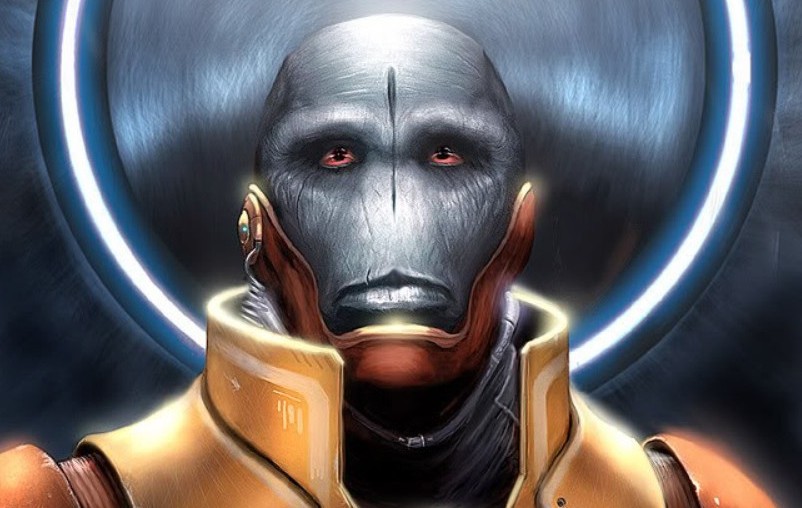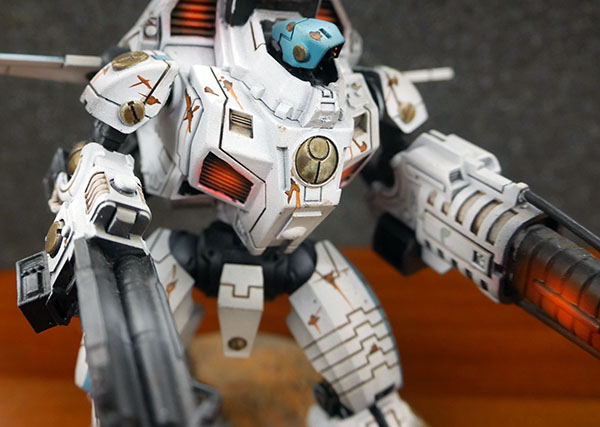
Hi folks. Today I’m taking another look at the post-FAQ updates to the T’au content in The Greater Good.
Last week, I discussed the changes that Games Workshop didn’t make. This week, I’ll talk about the changes that GW did make.
Moreover, I said last week that I thought that GW had dropped the ball with this update, and my opinion on this issue hasn’t changed.
The T’au section of the FAQ covers a little more than one page, and, as with any update, they’ve packed quite a number of small additions and changes to the book.
We begin with the addition of Shadowsun’s points cost. The Greater Good doesn’t actually specify what T’au players must pay in order to include her. This is quite a telling oversight. That they missed something this basic must mean something — exactly what it means, I don’t know. But plenty of players and pundits have discussed the issue of sub-par editorial work. I needn’t add any more to that particular discussion here. But I think it’s worth mentioning it to add context to the rest of this discussion.
Next we come to a clarification of the prototype weapons rules. The FAQ adds the following text: ‘No unit can have more than one Prototype Weapons System and all the Prototype Weapons Systems in your army must be different.’ As changes go, I’m not particularly bothered about this one. While it would’ve been great to have a couple of quad-Fusion Coldstars both with Cross-Linked Stabiliser Jets flying around the battlefield (this signature system allows the bearer to re-roll hit and wounds rolls of 1), I can appreciate why GW would want to add this limitation.
But here’s my concern: surely they thought of this before the original book was released. And if not, any play tester worth his salt would’ve pointed this out. This point will become something of a theme as we go through these changes.
Next, we come to the big one. It was this change that most perturbed me when I first read the document. The FAQ updates the Modulated Weaponry stratagem, changing the first sentence: ‘Use this Stratagem in your Shooting phase, when a Riptide, Ghostkeel or Vehicle model (other than a Titanic model) from your army is chosen to shoot with.’ Previously, the stratagem allowed any Sept model, other than Titanic models, to use the stratagem.
For those who don’t know, this stratagem allowed a model with a weapon that obliged the player to roll for its amount of shots to shoot that weapon at full capacity. For example, a Hammerhead armed with an Ion Cannon could shoot six shots, instead of d6 shots.
For one command point, this is a useful little stratagem, but GW clearly didn’t consider the whole range of models that could employ it. The XV 109 Y’Vahra Battlesuit is armed with a 2d6 flamer weapon that can become a 3d6 flamer weapon for the cost of a mortal wound. And it’s a really good flamer. At strength 6, AP-3, damage 3, this thing is an absolute monster.
Let’s presume that the T’au player has nova charged — which he almost certainly will have — and take the weapon at 3d6. The average on 3d6 is ten. And ten shots with this weapon can be deadly. But if we could use the stratagem, we would get 18 shots. Don’t get me wrong: 18 shots with the Phased Plasma Flamer would wreck most units in the game. 10 is strong; 18 is bedlam.

It would’ve made the Y’Vahra a deadly model, no doubt. But would it have made it too good? Would we have T’au lists with two, three Y’Vahras on the tabletop? I’m much more doubtful of this. The Y’Vahra is a great unit with some cool abilities — and the model itself looks pretty cool as well. But there’s one significant problem with it. It costs over 400 points. There’s a little bit of customization that T’au players can do — different support systems and the like — but the Y’Vahra is going to be around 400 points. Put simply, this is too much. If the Y’Vahra gets into range and hits a juicy target, it could very well make a decent return on the points investment. But there’s always the chance that it might not.
Why not? The answer is simple: the range of the flamer. At a modest 8″, the Phased Plasma Flamer just doesn’t give the Y’Vahra enough reach to be dangerous enough.
And yes, T’au players could run it in a Bork’an Sept detachment, increasing the range of the flamer by 6″. This would solve the problem — but it would also present a number of others. First, the Bork’an option isn’t particularly competitive. There are much better Sept options to choose from. That’s the first problem, but the second problem is much more pressing: the Savior Protocols rule is Sept-locked. This means that T’au Sept Drones can’t intercept wounds for a Bork’an Battlesuit. And this means that a T’au player couldn’t even take a cheap Bork’an outrider detachment in another T’au force: if he brings a Bork’an Y’Vahra, he must also bring enough Bork’an Drones to keep it alive.
There’s much more to go into here, but for now I’ve argued my point: even if it could use the Modulated Weaponry stratagem, I don’t think the Y’Vahra would be worth it. And this prompts the next question: why did GW choose to exclude the Y’Vahra from the units that could use it?
Now, reasonable people can come to different conclusions from the same set of facts. It’s perfectly sensible to think that GW thinks that the Y’Vahra would be too good if players could use this stratagem with it. But this doesn’t get GW out of the hot water. GW should have considered this before the release of The Greater Good.
Whether you agree that the Y’Vahra shouldn’t be allowed to use the stratagem or you disagree, GW doesn’t come out well. And if it were a one-time mistake, I would be a lot more understanding, but unfortunately this isn’t the case. As I’ve explained above and as many great players have pointed out, this happens just a little too often.
However, I’m fast coming up on my preferred word count for these articles, and there are still many more things to say about this FAQ. I’ll come to those points next week.
I’ll finish with this. GW has been releasing content at a significant rate recently. Overall, this is a really great thing. Many of you will recall the days of 4th or 5th edition when we were lucky to get three codex books a year. Not so any more.
But this rapid release schedule comes with trade-offs. Quality does, to one degree or another, suffer, and it’s going to be very interesting to see how GW deals with this issue. I will, however, end on a positive note, as I did last week: we’re still living through a golden age of the hobby. And most of the time GW knocks it out of the park.
And remember, Frontline Gaming sells gaming products at a discount, every day in their webcart!




Reece as a play-tester yourself surely you recognise that not every possible that every option can be play-tested in the short span of a book being compiled. There are simply too many players looking for any advantage to win in a game of toy soldiers.
The simple aim of PA was to add more flavour to the game and your particular army whilst making you have uncomfortable choices. Mine gained six different Masters of …. yet within a 1750/2000 points list I’m lucky to run one. I’m also finding that Tor Garadon is rarely used compared to the Chapter Master which is cheaper and offers more to my Heavy Support choices.
PA added in Theatres of War (of variable quality), a few missions and lots of flavour. It’s a start. But they were never going to raise armies to a par level with the SM Codex 2.
GW has made the decision that all FW are matched play (including ones they don’t even make!). If they’re not considering that in evaluating codex updates, that’s on them. If that was the only issue – well, one oversight is a lot less than 3 (or more).
This is the second book where they failed to include the points cost for their new character model. Once is a mistake, twice is a trend.
The issue with prototype weapons is a third issue with the editing of the book.
Yes, we’re all happy GW is putting out new content, and I think most people like the “everyone gets something” style of releases. But, their editing and play-testing of the books is pretty shoddy, which suggests things get through. Which likely explains the new Marine overlords (in particular Iron Hands). That’s not good for the long term. I was one of many that bailed on 40k around 5th edition, and really didn’t come back until 8th. While not the only reason for their sales growth and reduction, I think it explains at least some of Privateer Press sales gains and losses.
GW also made the decision that all Legends-stuff is still fully matched-play legal, that matched-play has no limit on the number of data-sheets and detachments you can use, and much more.
Most tournaments exclude a great deal and/or install additional limitations over and above the RAW matched-play rules on the basis of recommendations for genuinely competitive play, so following the same logic and giving FW a similar treatment to the new Legends or the 9-Patrol-Detachment-Drukhari-Army (e.g. fully matched play legal, but not necessarily suited for organized events / competitive play) wouldn’t be a big stretch.
The obvious answer is a digital subscription model to cover off the issues of a fast release schedule. Erratas and FAQ’s aren’t such big issues then, when things are missed.
I think GW still has the mindset that FW isn’t “really” 40k and doesn’t include those models in their thinking. It’s a mystery to me why they don’t as I’m pretty sure they like money. Selling models makes money. Why don’t they want to sell those models?
It’s also really sad as my favorite Tau stuff is FW.